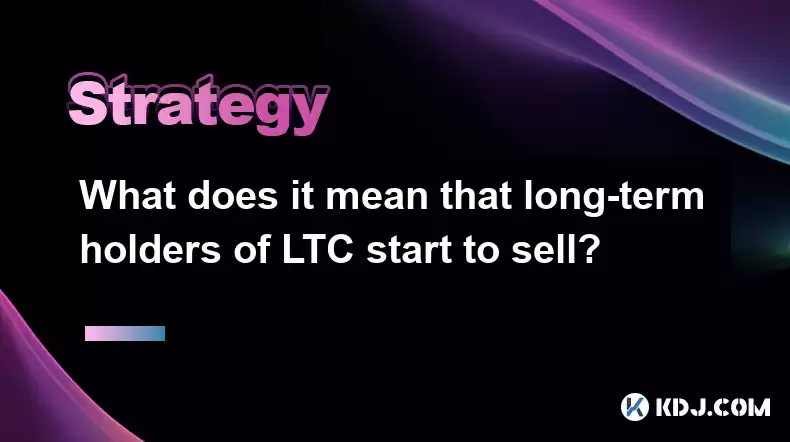-
 bitcoin
bitcoin $108842.957301 USD
-1.88% -
 ethereum
ethereum $3931.777121 USD
-1.66% -
 tether
tether $1.000186 USD
-0.03% -
 bnb
bnb $1153.250882 USD
-2.20% -
 xrp
xrp $2.367904 USD
-1.94% -
 solana
solana $186.182050 USD
-4.20% -
 usd-coin
usd-coin $0.999997 USD
0.00% -
 tron
tron $0.316949 USD
-1.00% -
 dogecoin
dogecoin $0.190780 USD
-3.12% -
 cardano
cardano $0.651324 USD
-2.67% -
 hyperliquid
hyperliquid $37.141055 USD
-0.85% -
 ethena-usde
ethena-usde $0.999224 USD
-0.09% -
 chainlink
chainlink $17.579031 USD
-2.47% -
 bitcoin-cash
bitcoin-cash $509.426284 USD
-2.79% -
 stellar
stellar $0.315298 USD
-2.93%
What does it mean that long-term holders of LTC start to sell?
Long-term Litecoin holders selling can signal a shift in market sentiment, potentially increasing supply and putting downward pressure on LTC's price.
Apr 26, 2025 at 04:56 am

The phenomenon of long-term holders of Litecoin (LTC) starting to sell can have significant implications for the cryptocurrency market. Long-term holders are typically investors who have held onto their LTC for an extended period, often believing in the long-term value and potential of the cryptocurrency. When these holders begin to sell, it can signal a shift in market sentiment and potentially affect the price and overall market dynamics of LTC.
Understanding Long-Term Holders
Long-term holders of LTC are investors who have kept their coins for months or even years. These individuals often have a strong belief in the future of Litecoin and are less likely to be influenced by short-term market fluctuations. They may have accumulated their LTC at various price points and are usually in it for the long haul, hoping to benefit from future price appreciation.
Reasons for Selling
There can be several reasons why long-term holders of LTC might start to sell their holdings. One common reason is profit-taking. If the price of LTC has significantly increased since they purchased it, holders might decide to cash in on their gains. Another reason could be changing market conditions. If long-term holders perceive that the market is turning bearish or that there are better investment opportunities elsewhere, they might decide to sell their LTC.
Additionally, personal financial needs can prompt long-term holders to sell. Life events such as buying a house, funding education, or dealing with emergencies can necessitate liquidating cryptocurrency holdings. Lastly, regulatory changes or technological developments in the crypto space might influence long-term holders to reevaluate their investment strategy and sell their LTC.
Impact on Litecoin's Price
When long-term holders of LTC start to sell, it can lead to an increase in the supply of LTC on the market. This increased supply can put downward pressure on the price, especially if the selling volume is significant. If the selling is concentrated over a short period, it can lead to a sharp decline in the price of LTC.
Conversely, if the selling is gradual and spread out over time, the impact on the price might be less severe. However, even gradual selling by long-term holders can contribute to a bearish sentiment in the market, as it signals that even those who were previously bullish on LTC are now less confident in its future value.
Market Sentiment and Trading Volume
The decision of long-term holders to sell can also influence market sentiment. When significant holders start to sell, it can create a domino effect, prompting other investors to follow suit. This can lead to increased trading volume and heightened volatility in the LTC market.
Moreover, the actions of long-term holders are often closely watched by other market participants. If influential holders start selling, it can be interpreted as a lack of confidence in LTC's future, which can further exacerbate bearish sentiment. On the other hand, if long-term holders are selling to rebalance their portfolios rather than exit the market entirely, the impact on sentiment might be less pronounced.
Analyzing On-Chain Data
To better understand the impact of long-term holders selling LTC, it's crucial to analyze on-chain data. On-chain metrics such as the HODL Waves and Coin Age Distribution can provide insights into the behavior of long-term holders. HODL Waves show the distribution of coins based on how long they have been held, while Coin Age Distribution indicates the age of coins being moved on the blockchain.
By examining these metrics, analysts can determine if the selling is coming from long-term holders and assess the potential impact on the market. For instance, if a significant portion of coins that have been dormant for years suddenly start moving, it could indicate that long-term holders are indeed selling.
Strategies for Investors
For investors holding LTC, the news of long-term holders selling can be concerning. However, there are several strategies that investors can employ to navigate such situations. One approach is to dollar-cost average (DCA) into their LTC holdings. By investing a fixed amount at regular intervals, investors can mitigate the impact of price volatility and potentially buy more LTC at lower prices.
Another strategy is to diversify their cryptocurrency portfolio. By spreading their investments across different assets, investors can reduce their exposure to the risks associated with a single cryptocurrency like LTC. Additionally, staying informed about market trends and on-chain data can help investors make more informed decisions about when to buy or sell LTC.
Monitoring Market Reactions
It's also important for investors to monitor how the market reacts to the selling by long-term holders. If the price of LTC stabilizes or even increases despite the selling, it could indicate strong underlying demand for the cryptocurrency. Conversely, if the price continues to decline, it might be a sign that the market is struggling to absorb the increased supply.
Investors should also pay attention to any news or developments related to Litecoin that could influence its price. Positive developments, such as upgrades to the Litecoin network or partnerships with major companies, could offset the impact of selling by long-term holders. Conversely, negative news could exacerbate the downward pressure on the price.
Frequently Asked Questions
Q: How can I identify if long-term holders are selling their LTC?A: To identify if long-term holders are selling their LTC, you can use on-chain analytics tools that provide metrics such as HODL Waves and Coin Age Distribution. These metrics can show the movement of coins that have been held for extended periods, indicating whether long-term holders are selling.
Q: What should I do if I see long-term holders of LTC selling?A: If you see long-term holders of LTC selling, consider your investment strategy. You might want to employ dollar-cost averaging to mitigate the impact of price volatility, diversify your portfolio to reduce risk, and stay informed about market trends and on-chain data to make more informed decisions.
Q: Can the selling by long-term holders of LTC be a buying opportunity for new investors?A: Yes, the selling by long-term holders can potentially create buying opportunities for new investors. If the price of LTC drops due to increased selling, new investors might be able to buy LTC at a lower price. However, it's important to conduct thorough research and consider the overall market conditions before making any investment decisions.
Q: How does the selling by long-term holders affect the overall cryptocurrency market?A: The selling by long-term holders of LTC can have a ripple effect on the broader cryptocurrency market. If the selling leads to a significant drop in LTC's price, it can contribute to a bearish sentiment that might affect other cryptocurrencies. Additionally, increased selling volume and volatility in the LTC market can influence trading activity and market dynamics across the crypto space.
Disclaimer:info@kdj.com
The information provided is not trading advice. kdj.com does not assume any responsibility for any investments made based on the information provided in this article. Cryptocurrencies are highly volatile and it is highly recommended that you invest with caution after thorough research!
If you believe that the content used on this website infringes your copyright, please contact us immediately (info@kdj.com) and we will delete it promptly.
- Cardano, Dogecoin, and the Token Rally: What's the Hype?
- 2025-10-17 22:45:16
- Milk Mocha Meme Coin: Last Call for Whitelist & Early HUGS Gains!
- 2025-10-17 22:45:16
- Crypto's New Sweetheart: Milk & Mocha's $HUGS Token and the Early Rounds Advantage
- 2025-10-17 22:25:12
- Crypto Picks for 2025: Blazpay Presale and Emerging Trends
- 2025-10-17 22:50:12
- Meme Coins: Riding the Early Bird Gold Rush
- 2025-10-17 23:05:12
- Shannon Man, Cash Prizes, and Coin Games: A New York Minute on a Georgia Arrest
- 2025-10-17 22:50:12
Related knowledge

Practical parameter settings for a Bitcoin multi-timeframe moving average system
Sep 18,2025 at 10:54pm
Optimizing Timeframe Combinations for Bitcoin Trading1. Selecting appropriate timeframes is crucial when building a multi-timeframe moving average sys...

How can I filter out false breakouts in Dogecoin high-frequency trading?
Sep 22,2025 at 01:00am
Understanding False Breakouts in Dogecoin Trading1. A false breakout occurs when Dogecoin's price appears to move beyond a defined support or resistan...

Techniques for identifying tops and bottoms in the Bitcoin on-chain NVT model
Sep 20,2025 at 07:54pm
Understanding the NVT Model in Bitcoin Analysis1. The Network Value to Transactions (NVT) ratio is often described as the 'P/E ratio' of the cryptocur...

What does the surge in open interest in Bitcoincoin futures mean?
Sep 20,2025 at 11:18pm
Understanding the Surge in Dogecoin Futures Open Interest1. A surge in open interest within Dogecoin futures indicates a growing number of active cont...

How can I use the Ethereum USDT premium to gauge market sentiment?
Sep 18,2025 at 11:55pm
Understanding the Ethereum USDT Premium1. The Ethereum USDT premium refers to the price difference between USDT (Tether) traded on Ethereum-based plat...

What should I do if Ethereum staking yields decline?
Sep 20,2025 at 06:18am
Understanding the Causes Behind Declining Ethereum Staking Yields1. The Ethereum network transitioned to a proof-of-stake consensus mechanism with the...

Practical parameter settings for a Bitcoin multi-timeframe moving average system
Sep 18,2025 at 10:54pm
Optimizing Timeframe Combinations for Bitcoin Trading1. Selecting appropriate timeframes is crucial when building a multi-timeframe moving average sys...

How can I filter out false breakouts in Dogecoin high-frequency trading?
Sep 22,2025 at 01:00am
Understanding False Breakouts in Dogecoin Trading1. A false breakout occurs when Dogecoin's price appears to move beyond a defined support or resistan...

Techniques for identifying tops and bottoms in the Bitcoin on-chain NVT model
Sep 20,2025 at 07:54pm
Understanding the NVT Model in Bitcoin Analysis1. The Network Value to Transactions (NVT) ratio is often described as the 'P/E ratio' of the cryptocur...

What does the surge in open interest in Bitcoincoin futures mean?
Sep 20,2025 at 11:18pm
Understanding the Surge in Dogecoin Futures Open Interest1. A surge in open interest within Dogecoin futures indicates a growing number of active cont...

How can I use the Ethereum USDT premium to gauge market sentiment?
Sep 18,2025 at 11:55pm
Understanding the Ethereum USDT Premium1. The Ethereum USDT premium refers to the price difference between USDT (Tether) traded on Ethereum-based plat...

What should I do if Ethereum staking yields decline?
Sep 20,2025 at 06:18am
Understanding the Causes Behind Declining Ethereum Staking Yields1. The Ethereum network transitioned to a proof-of-stake consensus mechanism with the...
See all articles










































































